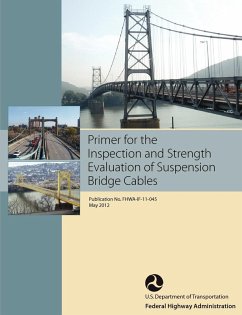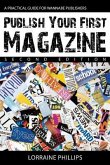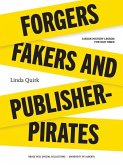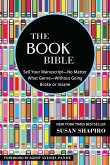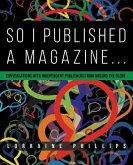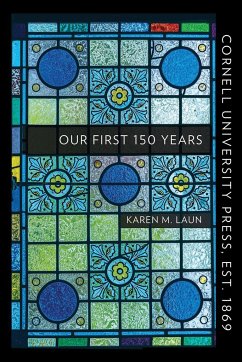Gwen Marchand, Matthew T McCrudden, Paul A. Schutz
Writing Mixed Methods Research for Publication
A Practical Guide
Versandkostenfrei innerhalb Deutschlands
72,99 €
inkl. MwSt.
Versandkostenfrei*
Erscheint vorauss. 14. Januar 2027
Melden Sie sich
hier
hier
für den Produktalarm an, um über die Verfügbarkeit des Produkts informiert zu werden.

36 °P sammeln
Gwen Marchand, Matthew T McCrudden, Paul A. Schutz
Writing Mixed Methods Research for Publication
A Practical Guide
- Broschiertes Buch
This practical guide equips instructors to help students publish rigorous mixed methods research by walking them through the article-writing process with clear strategies, discipline-spanning examples, and solutions to common challenges.
Andere Kunden interessierten sich auch für
![Primer for the Inspection and Strength Evaluation of Suspension Bridge Cables (Publication No. Fhwa-If-11-045) Primer for the Inspection and Strength Evaluation of Suspension Bridge Cables (Publication No. Fhwa-If-11-045)]() Federal Highway AdministrationPrimer for the Inspection and Strength Evaluation of Suspension Bridge Cables (Publication No. Fhwa-If-11-045)39,99 €
Federal Highway AdministrationPrimer for the Inspection and Strength Evaluation of Suspension Bridge Cables (Publication No. Fhwa-If-11-045)39,99 €![Publish Your First Magazine (Second Edition): A Practical Guide for Wannabe Publishers Publish Your First Magazine (Second Edition): A Practical Guide for Wannabe Publishers]() Lorraine PhillipsPublish Your First Magazine (Second Edition): A Practical Guide for Wannabe Publishers21,99 €
Lorraine PhillipsPublish Your First Magazine (Second Edition): A Practical Guide for Wannabe Publishers21,99 €![Business Correspondence; Correspondence English, Business Letter Writing Customs, Files and Systems, Writing Effective Business Letters Business Correspondence; Correspondence English, Business Letter Writing Customs, Files and Systems, Writing Effective Business Letters]() Burt Clifford BeanBusiness Correspondence; Correspondence English, Business Letter Writing Customs, Files and Systems, Writing Effective Business Letters20,99 €
Burt Clifford BeanBusiness Correspondence; Correspondence English, Business Letter Writing Customs, Files and Systems, Writing Effective Business Letters20,99 €![Forgers, Fakers, and Publisher-Pirates Forgers, Fakers, and Publisher-Pirates]() Linda QuirkForgers, Fakers, and Publisher-Pirates29,99 €
Linda QuirkForgers, Fakers, and Publisher-Pirates29,99 €![The Book Bible The Book Bible]() Susan ShapiroThe Book Bible12,99 €
Susan ShapiroThe Book Bible12,99 €![So I Published A Magazine: Conversations with Independent Publishers from Around the Globe So I Published A Magazine: Conversations with Independent Publishers from Around the Globe]() Lorraine PhillipsSo I Published A Magazine: Conversations with Independent Publishers from Around the Globe37,99 €
Lorraine PhillipsSo I Published A Magazine: Conversations with Independent Publishers from Around the Globe37,99 €![Cornell University Press, Est. 1869 Cornell University Press, Est. 1869]() Karen M LaunCornell University Press, Est. 186910,99 €
Karen M LaunCornell University Press, Est. 186910,99 €-
-
-
This practical guide equips instructors to help students publish rigorous mixed methods research by walking them through the article-writing process with clear strategies, discipline-spanning examples, and solutions to common challenges.
Produktdetails
- Produktdetails
- Verlag: SAGE Publications Inc
- Seitenzahl: 240
- Erscheinungstermin: 14. Januar 2027
- Englisch
- Abmessung: 228mm x 152mm
- ISBN-13: 9781071833568
- ISBN-10: 1071833561
- Artikelnr.: 75283971
- Herstellerkennzeichnung
- Libri GmbH
- Europaallee 1
- 36244 Bad Hersfeld
- gpsr@libri.de
- Verlag: SAGE Publications Inc
- Seitenzahl: 240
- Erscheinungstermin: 14. Januar 2027
- Englisch
- Abmessung: 228mm x 152mm
- ISBN-13: 9781071833568
- ISBN-10: 1071833561
- Artikelnr.: 75283971
- Herstellerkennzeichnung
- Libri GmbH
- Europaallee 1
- 36244 Bad Hersfeld
- gpsr@libri.de
Matthew T. McCrudden is an associate professor in the School of Education at Victoria University of Wellington, New Zealand. His research examines how tasks, reader characteristics, and text features affect cognitive processes that occur during reading and post-reading products related to learning and beliefs. He currently serves as an associate editor of the journal Contemporary Educational Psychology.
Series Editor Introduction
Preface
Acknowledgements
About the Authors
Chapter 1: Features of Empirical Mixed Methods Journal Articles
Empirical Mixed Methods Journal Articles
Unique Features of Empirical Mixed Methods Journal Articles
Concluding Comments
Exercises: Understanding the Features of Empirical Mixed Methods Journal
Articles
Additional Resources
Checklist: Features of Empirical Mixed Methods Journal Articles
Chapter 2: Selecting a Journal for an Empirical Mixed Methods Manuscript
The Journal Review Process
Selecting a Journal for Your Empirical Mixed Methods Manuscript
Concluding Comments
Exercises: Evaluating the Fit Between a Journal and Your Manuscript
Additional Resources
Checklist: Selecting a Journal for an Empirical Mixed Methods Manuscript
Chapter 3: Writing the Introduction and Literature Review Section of an
Empirical Mixed Methods Manuscript
Writing Your Introduction
Writing Your Literature Review
Positionality Statement
Concluding Comments
Exercises: Activities for Writing Your Introduction and Literature Review
Section
Additional Resources
Checklist: Writing the Introduction and Literature Review Section of an
Empirical Mixed Methods Manuscript
Chapter 4: Writing the Methods Section of an Empirical Mixed Methods
Manuscript
Organizing the Methods Section
Components of the Methods Section
Concluding Comments
Exercises: Writing Activities for Your Methods Section
Additional Resources
Checklist: Writing the Methods Section of an Empirical Mixed Methods
Manuscript
Chapter 5: Writing the Results Section of an Empirical Mixed Methods
Manuscript
Organizing a Mixed Methods Results Section
Decision Points When Writing Your Results Section
Writing the Results for the Reviewer/Reader
Concluding Comments
Exercises: Writing Activities for Your Results Section
Additional Resources
Checklist: Writing the Results Section of an Empirical Mixed Method
Manuscript
Chapter 6: Writing the Discussion Section of an Empirical Mixed Methods
Manuscript
Organizing the Discussion Section
Components of the Discussion Section
Concluding Comments
Exercises: Activities for Writing Your Discussion Section
Additional Resources
Checklist: Writing the Discussion Section of an Empirical Mixed Methods
Manuscript
Chapter 7: Using Joint Displays in an Empirical Mixed Methods Manuscript
Using Joint Displays to Enhance Integration
General Guidelines for Developing Joint Displays
Using Joint Displays to Communicate the Integration of Methods
Using Joint Displays to Communicate the Integration of Results:
Side-by-Side Display
Concluding Comments
Exercises: Activities for Developing Your Joint Displays
Additional Resources
Checklist: Using Joint Displays in an Empirical Mixed Methods Manuscript
Chapter 8: Writing the Title, Abstract, and Other Elements of an Empirical
Mixed Methods Manuscript
Writing the Title for Your Empirical Mixed Methods Manuscript
Writing the Abstract for Your Empirical Mixed Methods Manuscript
Other Elements of Your Mixed Methods Manuscript
Concluding Comments and Final Words of Advice
Exercises: Activities for Writing the Title, Abstract, and Other Elements
of Your Empirical Mixed Methods Manuscript
Additional Resources
Checklist: Writing the Title, Abstract, and Other Elements of an Empirical
Mixed Methods Manuscript
Appendix
References
Preface
Acknowledgements
About the Authors
Chapter 1: Features of Empirical Mixed Methods Journal Articles
Empirical Mixed Methods Journal Articles
Unique Features of Empirical Mixed Methods Journal Articles
Concluding Comments
Exercises: Understanding the Features of Empirical Mixed Methods Journal
Articles
Additional Resources
Checklist: Features of Empirical Mixed Methods Journal Articles
Chapter 2: Selecting a Journal for an Empirical Mixed Methods Manuscript
The Journal Review Process
Selecting a Journal for Your Empirical Mixed Methods Manuscript
Concluding Comments
Exercises: Evaluating the Fit Between a Journal and Your Manuscript
Additional Resources
Checklist: Selecting a Journal for an Empirical Mixed Methods Manuscript
Chapter 3: Writing the Introduction and Literature Review Section of an
Empirical Mixed Methods Manuscript
Writing Your Introduction
Writing Your Literature Review
Positionality Statement
Concluding Comments
Exercises: Activities for Writing Your Introduction and Literature Review
Section
Additional Resources
Checklist: Writing the Introduction and Literature Review Section of an
Empirical Mixed Methods Manuscript
Chapter 4: Writing the Methods Section of an Empirical Mixed Methods
Manuscript
Organizing the Methods Section
Components of the Methods Section
Concluding Comments
Exercises: Writing Activities for Your Methods Section
Additional Resources
Checklist: Writing the Methods Section of an Empirical Mixed Methods
Manuscript
Chapter 5: Writing the Results Section of an Empirical Mixed Methods
Manuscript
Organizing a Mixed Methods Results Section
Decision Points When Writing Your Results Section
Writing the Results for the Reviewer/Reader
Concluding Comments
Exercises: Writing Activities for Your Results Section
Additional Resources
Checklist: Writing the Results Section of an Empirical Mixed Method
Manuscript
Chapter 6: Writing the Discussion Section of an Empirical Mixed Methods
Manuscript
Organizing the Discussion Section
Components of the Discussion Section
Concluding Comments
Exercises: Activities for Writing Your Discussion Section
Additional Resources
Checklist: Writing the Discussion Section of an Empirical Mixed Methods
Manuscript
Chapter 7: Using Joint Displays in an Empirical Mixed Methods Manuscript
Using Joint Displays to Enhance Integration
General Guidelines for Developing Joint Displays
Using Joint Displays to Communicate the Integration of Methods
Using Joint Displays to Communicate the Integration of Results:
Side-by-Side Display
Concluding Comments
Exercises: Activities for Developing Your Joint Displays
Additional Resources
Checklist: Using Joint Displays in an Empirical Mixed Methods Manuscript
Chapter 8: Writing the Title, Abstract, and Other Elements of an Empirical
Mixed Methods Manuscript
Writing the Title for Your Empirical Mixed Methods Manuscript
Writing the Abstract for Your Empirical Mixed Methods Manuscript
Other Elements of Your Mixed Methods Manuscript
Concluding Comments and Final Words of Advice
Exercises: Activities for Writing the Title, Abstract, and Other Elements
of Your Empirical Mixed Methods Manuscript
Additional Resources
Checklist: Writing the Title, Abstract, and Other Elements of an Empirical
Mixed Methods Manuscript
Appendix
References
Series Editor Introduction
Preface
Acknowledgements
About the Authors
Chapter 1: Features of Empirical Mixed Methods Journal Articles
Empirical Mixed Methods Journal Articles
Unique Features of Empirical Mixed Methods Journal Articles
Concluding Comments
Exercises: Understanding the Features of Empirical Mixed Methods Journal
Articles
Additional Resources
Checklist: Features of Empirical Mixed Methods Journal Articles
Chapter 2: Selecting a Journal for an Empirical Mixed Methods Manuscript
The Journal Review Process
Selecting a Journal for Your Empirical Mixed Methods Manuscript
Concluding Comments
Exercises: Evaluating the Fit Between a Journal and Your Manuscript
Additional Resources
Checklist: Selecting a Journal for an Empirical Mixed Methods Manuscript
Chapter 3: Writing the Introduction and Literature Review Section of an
Empirical Mixed Methods Manuscript
Writing Your Introduction
Writing Your Literature Review
Positionality Statement
Concluding Comments
Exercises: Activities for Writing Your Introduction and Literature Review
Section
Additional Resources
Checklist: Writing the Introduction and Literature Review Section of an
Empirical Mixed Methods Manuscript
Chapter 4: Writing the Methods Section of an Empirical Mixed Methods
Manuscript
Organizing the Methods Section
Components of the Methods Section
Concluding Comments
Exercises: Writing Activities for Your Methods Section
Additional Resources
Checklist: Writing the Methods Section of an Empirical Mixed Methods
Manuscript
Chapter 5: Writing the Results Section of an Empirical Mixed Methods
Manuscript
Organizing a Mixed Methods Results Section
Decision Points When Writing Your Results Section
Writing the Results for the Reviewer/Reader
Concluding Comments
Exercises: Writing Activities for Your Results Section
Additional Resources
Checklist: Writing the Results Section of an Empirical Mixed Method
Manuscript
Chapter 6: Writing the Discussion Section of an Empirical Mixed Methods
Manuscript
Organizing the Discussion Section
Components of the Discussion Section
Concluding Comments
Exercises: Activities for Writing Your Discussion Section
Additional Resources
Checklist: Writing the Discussion Section of an Empirical Mixed Methods
Manuscript
Chapter 7: Using Joint Displays in an Empirical Mixed Methods Manuscript
Using Joint Displays to Enhance Integration
General Guidelines for Developing Joint Displays
Using Joint Displays to Communicate the Integration of Methods
Using Joint Displays to Communicate the Integration of Results:
Side-by-Side Display
Concluding Comments
Exercises: Activities for Developing Your Joint Displays
Additional Resources
Checklist: Using Joint Displays in an Empirical Mixed Methods Manuscript
Chapter 8: Writing the Title, Abstract, and Other Elements of an Empirical
Mixed Methods Manuscript
Writing the Title for Your Empirical Mixed Methods Manuscript
Writing the Abstract for Your Empirical Mixed Methods Manuscript
Other Elements of Your Mixed Methods Manuscript
Concluding Comments and Final Words of Advice
Exercises: Activities for Writing the Title, Abstract, and Other Elements
of Your Empirical Mixed Methods Manuscript
Additional Resources
Checklist: Writing the Title, Abstract, and Other Elements of an Empirical
Mixed Methods Manuscript
Appendix
References
Preface
Acknowledgements
About the Authors
Chapter 1: Features of Empirical Mixed Methods Journal Articles
Empirical Mixed Methods Journal Articles
Unique Features of Empirical Mixed Methods Journal Articles
Concluding Comments
Exercises: Understanding the Features of Empirical Mixed Methods Journal
Articles
Additional Resources
Checklist: Features of Empirical Mixed Methods Journal Articles
Chapter 2: Selecting a Journal for an Empirical Mixed Methods Manuscript
The Journal Review Process
Selecting a Journal for Your Empirical Mixed Methods Manuscript
Concluding Comments
Exercises: Evaluating the Fit Between a Journal and Your Manuscript
Additional Resources
Checklist: Selecting a Journal for an Empirical Mixed Methods Manuscript
Chapter 3: Writing the Introduction and Literature Review Section of an
Empirical Mixed Methods Manuscript
Writing Your Introduction
Writing Your Literature Review
Positionality Statement
Concluding Comments
Exercises: Activities for Writing Your Introduction and Literature Review
Section
Additional Resources
Checklist: Writing the Introduction and Literature Review Section of an
Empirical Mixed Methods Manuscript
Chapter 4: Writing the Methods Section of an Empirical Mixed Methods
Manuscript
Organizing the Methods Section
Components of the Methods Section
Concluding Comments
Exercises: Writing Activities for Your Methods Section
Additional Resources
Checklist: Writing the Methods Section of an Empirical Mixed Methods
Manuscript
Chapter 5: Writing the Results Section of an Empirical Mixed Methods
Manuscript
Organizing a Mixed Methods Results Section
Decision Points When Writing Your Results Section
Writing the Results for the Reviewer/Reader
Concluding Comments
Exercises: Writing Activities for Your Results Section
Additional Resources
Checklist: Writing the Results Section of an Empirical Mixed Method
Manuscript
Chapter 6: Writing the Discussion Section of an Empirical Mixed Methods
Manuscript
Organizing the Discussion Section
Components of the Discussion Section
Concluding Comments
Exercises: Activities for Writing Your Discussion Section
Additional Resources
Checklist: Writing the Discussion Section of an Empirical Mixed Methods
Manuscript
Chapter 7: Using Joint Displays in an Empirical Mixed Methods Manuscript
Using Joint Displays to Enhance Integration
General Guidelines for Developing Joint Displays
Using Joint Displays to Communicate the Integration of Methods
Using Joint Displays to Communicate the Integration of Results:
Side-by-Side Display
Concluding Comments
Exercises: Activities for Developing Your Joint Displays
Additional Resources
Checklist: Using Joint Displays in an Empirical Mixed Methods Manuscript
Chapter 8: Writing the Title, Abstract, and Other Elements of an Empirical
Mixed Methods Manuscript
Writing the Title for Your Empirical Mixed Methods Manuscript
Writing the Abstract for Your Empirical Mixed Methods Manuscript
Other Elements of Your Mixed Methods Manuscript
Concluding Comments and Final Words of Advice
Exercises: Activities for Writing the Title, Abstract, and Other Elements
of Your Empirical Mixed Methods Manuscript
Additional Resources
Checklist: Writing the Title, Abstract, and Other Elements of an Empirical
Mixed Methods Manuscript
Appendix
References

